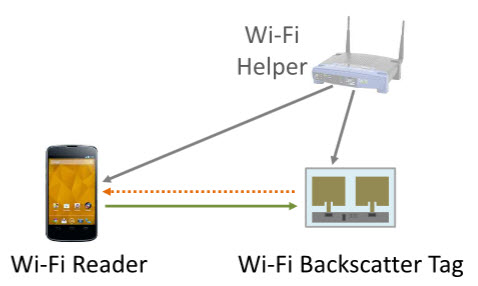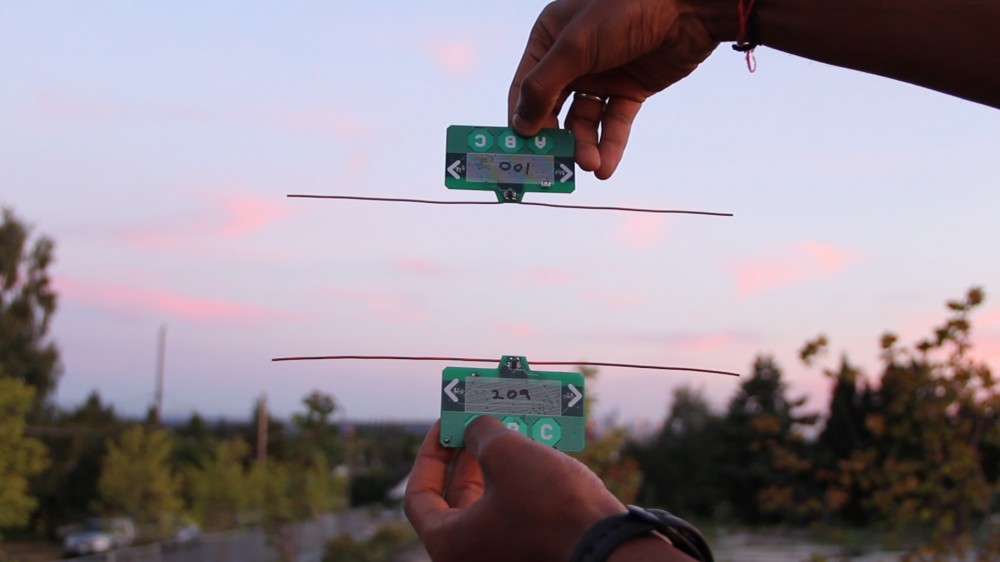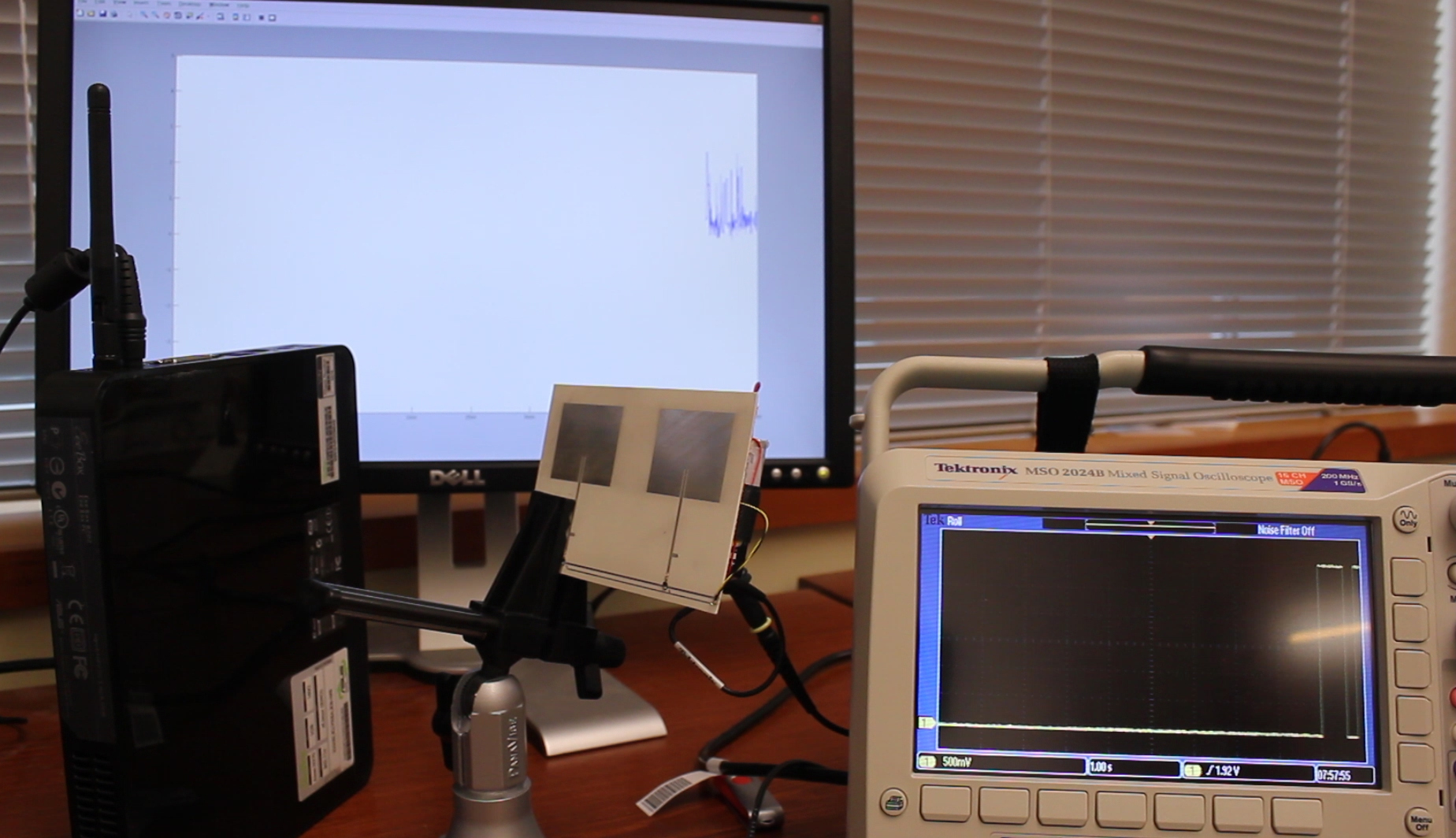How to enable the Internet of Things without batteries
August 6, 2014

The basic Wi-Fi Backscatter system includes an ambient-RF-powered device (Wi-Fi Backscatter tag, attached to a temperature sensor, for example) that modulates (by reflecting of not reflecting) signals from a Wi-Fi access point (“helper”), and a reader (such as a cell phone) that detects these reflected signals and decodes (the data (such as a change of temperature). (Credit: University of Washington)
University of Washington engineers have designed a clever new communication system called Wi-Fi backscatter that uses ambient radio frequency signals as a power source for battery-free devices (such as temperature sensors or wearable technology) and also reuses the existing Wi-Fi infrastructure to provide Internet connectivity for these devices.
“If Internet of Things devices are going to take off, we must provide connectivity to the potentially billions of battery-free devices that will be embedded in everyday objects,” said Shyam Gollakota, a UW assistant professor of computer science and engineering.
“We now have the ability to enable Wi-Fi connectivity for devices while consuming orders of magnitude less power than what Wi-Fi typically requires.”

Demonstration of the UW ambient backscatter system. Here, a payment card transfers funds to another card by leveraging the ambient wireless signals around them, acting as both the power source and the communication medium. (Credit: University of Washington)
To supply power to the devices, the system uses an “ambient backscatter” scheme previously developed by the UW group, which allows two devices to communicate with each other by harvesting ambient radio, TV, and cellular transmissions, as KurzweilAI described last year.
So the new research takes that a step further by also connecting each individual device to the Internet.
But but even low-power Wi-Fi consumes 1000 to 10,000 times more power than can be harvested in these wireless signals. Instead, the new system uses an ultra-low-power “tag” with an antenna and circuitry that can talk to Wi-Fi-enabled laptops or smartphones while consuming negligible power (less than 10 microwatts).

Prototype WiFi backscatter equipment: transmitter, WiFi receiver, and oscilloscope (in front) (credit: University of Washington)
These tags work by essentially “looking” for Wi-Fi signals moving between the router and a laptop or smartphone. The tags encode data in real time by either reflecting or not reflecting the Wi-Fi router’s signals, thus slightly changing the wireless signal.
Wi-Fi-enabled devices like laptops and smartphones would detect these minute changes (by analyzing changes in reflected signals) and receive data from the tag.
So far, the UW’s Wi-Fi backscatter tag has communicated with a Wi-Fi device at rates of 1 kilobit per second with about 2 meters between the devices. The researchers plan to extend the range to about 20 meters and have filed patents on the technology.
The “Internet of Things” would extend connectivity to perhaps billions of devices. Battery-free sensors could be embedded in everyday objects to help monitor and track everything from the structural safety of bridges to the health of your heart. For example, your smart watch could upload your workout data onto a Google spreadsheet.
Or sensors embedded around your home could track minute-by-minute temperature changes and send that information to your thermostat to help conserve energy.
The researchers will publish their results at the Association for Computing Machinery’s Special Interest Group on Data Communication‘s annual conference this month in Chicago. The team also plans to start a company based on the technology.
The research was funded by the UW Commercialization Gap Fund, the Qualcomm Innovation Fellowship, Washington Research Foundation, the National Science Foundation, and the UW.
University of Washington | We present Wi-Fi Backscatter, a novel communication system that bridges RF-powered devices with the Internet. Specifically, we show that it is possible to reuse existing Wi-Fi infrastructure to provide Internet connectivity to RF-powered devices. We believe that this new capability can pave the way for the rapid deployment and adoption of RF-powered devices and achieve ubiquitous connectivity via nearby mobile devices that are Wi-Fi enabled.
Abstract of Association for Computing Machinery’s Special Interest Group on Data Communication‘s annual conference paper
RF-powered computers are small devices that compute and communicate using only the power that they harvest from RF signals.While existing technologies have harvested power from ambient RF sources (e.g., TV broadcasts), they require a dedicated gateway (like an RFID reader) for Internet connectivity. We present Wi-Fi Backscatter, a novel communication system that bridges RF-powered devices with the Internet. Specifically, we show that it is possible to reuse existing Wi-Fi infrastructure to provide Internet connectivity to RF-powered devices. To show Wi-Fi Backscatter’s feasibility, we build a hardware prototype and demonstrate the first communication link between an RF-powered device and commodity Wi-Fi devices. We use off-the-shelf Wi-Fi devices including Intel Wi-Fi cards, Linksys Routers, and our organization’s Wi-Fi infrastructure, and achieve communication rates of up to 1 kbps and ranges of up to 2.1 meters. We believe that this new capability can pave the way for the rapid deployment and adoption of RF-powered devices and achieve ubiquitous connectivity via nearby mobile devices that are Wi-Fi enabled.